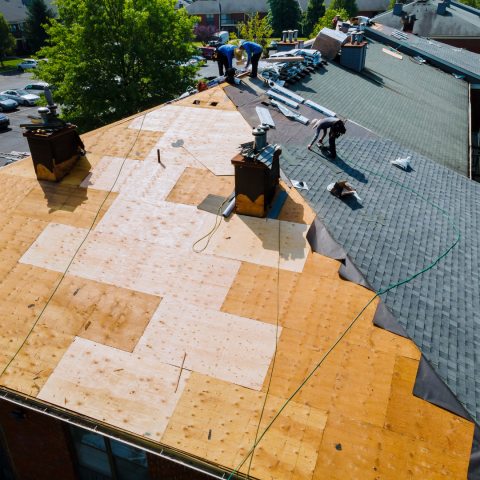Understanding the key parts of a roof is crucial for homeowners and builders alike. From the protective roof covering to the structural elements providing support, each component plays a vital role in safeguarding your home from the elements. By familiarizing yourself with the various components that make up a roof, you can better appreciate its functionality and make informed decisions when it comes to maintenance or repairs.
Roofs consist of several vital parts, each serving a specific purpose. The main parts of a roof include roof covering (shingles, tiles, or metal sheets), roof sheathing, roof trusses or rafters, underlayment, flashing, and gutters. These elements work together to create a sturdy and weather-resistant roofing system.
Key Parts of a Roof
- The Roof Covering: Protecting Your Home
The roof covering is an essential component of your roof, serving as the primary protective layer against the elements. It plays a vital role in safeguarding your home from rain, snow, wind, and other weather conditions. Here are some different types of roof coverings and their characteristics.
- Asphalt Shingles: These are cost-effective, durable roof coverings available in various styles and colors. They offer good protection against UV rays and have decent fire resistance. However, they may require maintenance and have a shorter lifespan compared to some other roofing materials.
- Clay or Concrete Tiles: It provides a timeless and durable roofing solution. They offer excellent resistance to weather and fire, requiring minimal maintenance. However, their weight necessitates proper structural support, and they can be more expensive to install and replace.
- Metal Sheets: They provide durable and long-lasting roof coverings. They are lightweight, fire-resistant, and environmentally friendly. Metal roofs can withstand harsh weather conditions and offer versatile design options. However, they can be more expensive upfront and may require proper insulation to reduce noise.
Choose a roof covering based on budget, climate, style, and preferences. Consult a professional roofing contractor for expert guidance tailored to your home’s needs.
- Roof Sheathing: Providing Structural Support
Roof sheathing is a critical component of the roofing system that provides structural support and a solid base for the roof covering. It is typically made of plywood or oriented strand board (OSB) and is installed over the roof trusses or rafters. Roof sheathing plays a crucial role in distributing the weight of the roof evenly and helps to strengthen the overall structure of the roof.
Additionally, it provides a flat and smooth surface for the installation of the roof covering and helps to prevent moisture intrusion. Proper installation and maintenance of roof sheathing are essential for the longevity and integrity of the roofing system.
- Roof Trusses or Rafters: Structural Framework
Roof trusses or rafters are the structural frameworks that support the weight of the roof. They are designed to bear the load and distribute it evenly across the walls and foundation of the building. Trusses are prefabricated triangular structures, while rafters are traditional beams that span the width of the roof.
The choice between trusses and rafters depends on various factors, including the desired roof shape, architectural design, local building codes, and the load-bearing capacity required. Trusses are commonly used in residential and commercial construction due to their efficiency and cost-effectiveness. However, in certain cases where customization or architectural aesthetics are of utmost importance, rafters may be preferred.
It is crucial to consult with a structural engineer or a professional roofing contractor to determine the most suitable roof support system for your specific needs. They will assess factors such as the roof design, span, load-bearing requirements, and local building regulations to ensure the structural integrity and safety of your roof.
- Underlayment: Additional Protection
Underlayment is an extra layer of protection that is installed between the roof sheathing and the roof covering. Its primary purpose is to provide an additional barrier against moisture infiltration and prevent leaks. By acting as a secondary waterproofing layer, underlayment helps to safeguard the roof structure and the interior of the building from potential water damage.
There are different types of underlayment available, each with its own characteristics and benefits. Asphalt-saturated felt is a traditional choice that offers good water resistance and durability. Synthetic underlayment, on the other hand, is becoming increasingly popular due to its superior tear resistance, breathability, and lightweight nature. Rubberized asphalt membranes provide excellent waterproofing properties and are often used in areas prone to heavy rainfall or extreme weather conditions.
The specific type of underlayment chosen will depend on factors such as climate, building codes, and personal preferences. The correct installation of underlayment is essential for maximizing its effectiveness and durability. It is typically installed in overlapping layers, starting from the eaves and working upwards towards the ridge.
By including underlayment in your roofing system, you can enhance the overall thermal efficiency of the roof, improve its resistance to water penetration, and contribute to the longevity of the roof covering.
- Flashing: Waterproofing Vulnerable Areas
Flashing is an essential component of a roof’s waterproofing system. Its primary function is to ensure water tightness in vulnerable areas where the roof meets other structures or penetrations, such as chimneys, vents, skylights, or dormers. By creating a barrier, flashing helps to redirect water away from these critical points and prevent water infiltration.
Flashing is typically made of durable materials such as aluminum, copper, or galvanized steel. These materials are chosen for their resistance to corrosion and ability to withstand the elements. The specific type of flashing used may vary depending on the roof design, climate conditions, and the specific area it is intended to protect.
Proper installation of flashing is crucial to its effectiveness. It should be securely fastened and integrated with the surrounding roofing materials to create a watertight seal. Careful attention must be given to ensure that flashing is correctly positioned and properly overlapped to provide optimal protection against water penetration.
With proper flashing in your roofing system, you can help ensure water tightness, protect against moisture-related issues, and prolong the lifespan of your roof.
- Gutters: Managing Rainwater
Gutters are an essential component of a well-functioning roofing system as they effectively manage rainwater runoff. By collecting water from the roof surface, gutters prevent it from cascading directly down the sides of the building, which can lead to various water-related issues.
Gutters are available in different materials, including aluminum, steel, vinyl, and copper. Each material has its advantages in terms of durability, aesthetics, and cost. The choice of gutter material depends on factors such as climate, budget, and personal preference.
Regular cleaning is necessary to remove leaves, debris, and other obstructions that can hinder water flow. Clogged gutters can cause water to overflow, leading to potential damage to the roof, fascia, and foundation.
Downspouts, which are connected to the gutters, play a vital role in directing water away from the building’s foundation. Extensions or splash blocks can be installed at the bottom of downspouts to ensure that water is discharged at a safe distance from the foundation, preventing potential water damage and foundation issues.
Remember to consult with a professional roofing contractor for guidance on gutter installation, maintenance, and repairs to ensure optimal performance and longevity of your gutter system.
How often should I inspect and maintain my roof?
It is recommended to inspect your roof at least twice a year, ideally in the spring and fall. Regular inspections can help identify any signs of damage, such as missing or damaged shingles, cracked flashing, or clogged gutters. Additionally, after severe weather events like storms or heavy snowfall, it’s crucial to check for any potential roof damage promptly. Regular maintenance, such as cleaning gutters and trimming nearby trees, can also extend the lifespan of your roof.
Take control of your roof’s integrity and longevity. Understand the key parts of a roof and make informed decisions for maintenance, repairs, and selecting the right materials. Equip yourself with the knowledge to safeguard your home. Contact Just Roofs and Gutters to guide you in your roofing needs.





